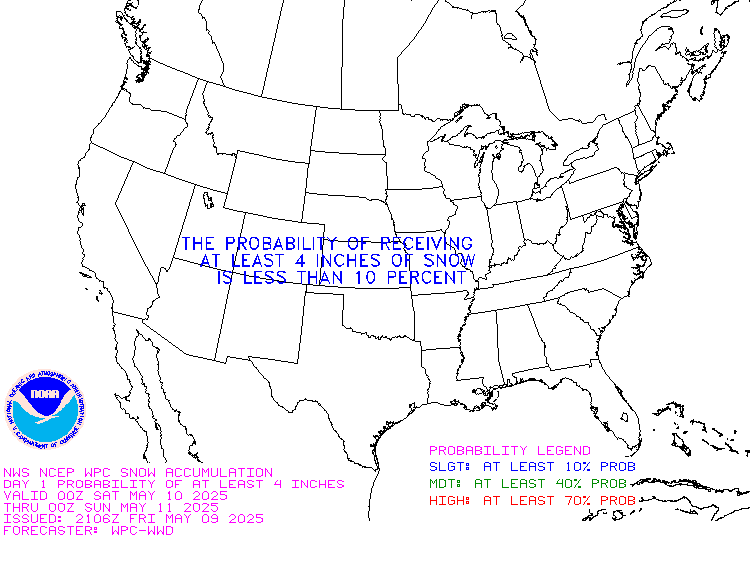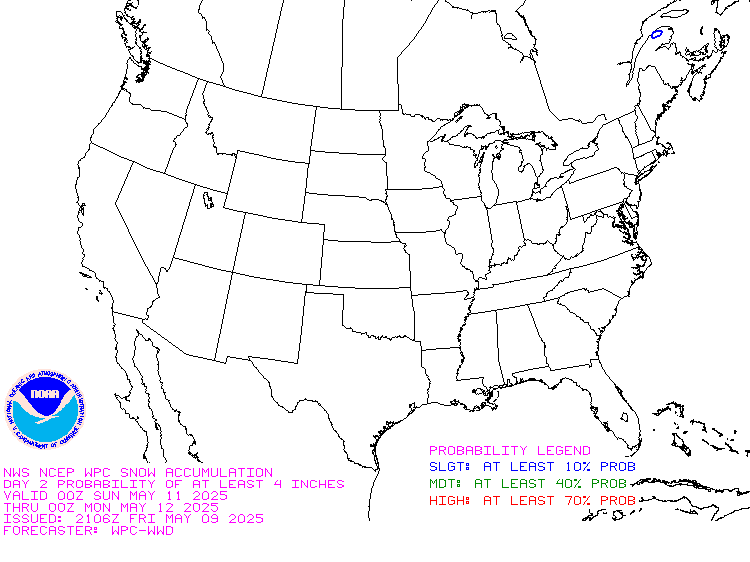It is difficult to find a more comprehensive Weather Outlook anywhere else with the ability to get a local 10-day Forecast also.
This article focuses on what we are paying attention to in the next 48 to 72 hours. The article also includes weather maps for longer-term U.S. outlooks and a six-day World weather outlook which can be very useful for travelers.
First the highlights from the NWS.
Short Range Forecast Discussion
NWS Weather Prediction Center College Park MD
Mon Feb 05 2024
Valid 12Z Mon Feb 05 2024 – 12Z Wed Feb 07 2024…Life threatening Flash Flooding continues for Southern California
Monday……Heavy Snow for parts of the Sierra Nevada, Great Basin, Northern
Rockies, and Four Corners Region……Much above average high temperatures continue for the Northern/Central
Plains and Upper Midwest…
Looking out a bit farther and focusing on the more series events:
Above is a 72 hour animation of the forecast.
Then, looking at the world and of course, the U.S. shows here also. Today we are looking at precipitation.
Please click on “Read More” below to access the full report issued today.
| Notices: The article on the Seasonal Outlook can be accessed HERE. What would you like to learn about? Please provide that to me via the comment section at the end of the article. |
Now more detail on the 48-Hour Forecast (It is a 48 to 72 Hour Forecast actually)
Daily weather maps. The Day 1 map updates twice a day and the Day 2 and 3 maps update only once a day. These maps update automatically. But if that does not happen, you can get updates by clicking HERE
TODAY (or late in the day the evening/overnight map will appear) (Key to surface fronts shown on maps and you will then also be able to insert a city name or zip code and get a local NWS forecast).
TOMORROW
NEXT DAY
This animation shows how things may play out over the next 60 hours. To update click here.
The NWS Climate Prediction Center’s: Watches, Warnings, and Advisories plus other information can be found HERE. We post at least one of those updates daily, sometimes both. The Highlights are shown in the lede paragraph of this article.
ATMOSPHERIC RIVERS
This tells us what is approaching the West Coast. Click HERE to update If I have not gotten around to doing the update. Here is some useful information about Atmospheric Rivers.
Continuation of the NWS Short Range Forecast. It is updated by NWS twice a day and these updates can be found here
The threat for flash flooding centers on Southern California Monday as a
deep upper-level trough/Pacific storm system and associated Atmospheric
River slowly pivots along the West Coast and pushes further inland.
Ongoing showers and thunderstorms will continue to produce very heavy
rainfall fueled by the influx of anomalously high moisture, favorable
upslope flow, and increasing instability. A High Risk of Excessive
Rainfall (level 4/4) is once again in effect Monday for portions of the LA
Basin and the eastern Transverse Ranges, with an encompassing Moderate
Risk (level 3/4) extending westward along the Transverse Ranges and
southward along the Peninsular Ranges. Additional rainfall totals
generally between 5-8″ will be possible, which will bring 48-totals as
high as 8-14″ for some locations. Increasingly saturated conditions and
ongoing flooding will be further exacerbated by this additional rainfall,
continuing the threat for life-threatening, locally catastrophic flash,
urban, and small stream flooding, as well as a threat for debris flows and
mudslides. A Slight Risk remains in effect for lingering locally heavy
rainfall northwestward towards the central California coast, and also into
portions of the Mojave Desert. In addition, some strong gusty winds will
remain possible, though wind speeds/gusts should be trending downward
overall. Coastal flooding and high surf will also remain a concern through
Monday evening.Very heavy mountain snows will continue for higher elevations of the
Sierra Nevada, generally above 5000 feet, with storm total snowfall of
several feet expected. Snowfall rates of 2-3″/hr and gusty winds upwards
of 60 mph will keep travel dangerous to impossible due to whiteout
conditions. Moisture from the system will also continue to spread further
inland, bringing heavy higher elevation snows to the regional mountain
ranges of the Central Great Basin of Nevada northeastward into portions of
the Northern Rockies of Idaho and Wyoming Monday, and into the Four
Corners region Tuesday. Storm total snowfall of around foot will be
common, with some locally higher totals of 2+ feet possible. Lower
elevations of the Great Basin will see a mix of rain and some snow, but
any snow accumulations should be limited. Further south into the Desert
Southwest, the ongoing influx of moisture will lead to heavier rainfall
Tuesday, with a Slight Risk of Excessive Rainfall in effect for portions
of western Arizona and Southern Nevada. Rainfall totals generally between
1-3″ may lead to some scattered instances of flash flooding.Elsewhere, some moderate to locally heavy showers are expected further
north from Northern California into the Pacific Northwest as the Pacific
system pushes inland. Some showers and thunderstorms will remain possible
for portions of Florida and northeastward along coastal Georgia and South
Carolina as a low pressure system pushes away from the coast. The rest of
the central and eastern U.S. should remain dry. High temperatures will
remain anomalously warm for the Northern/Central Plains and Upper Midwest
as upper-level ridging remains in place. High temperatures in the 40s and
low 50s are upwards of 20-30 degrees above average. Some daily
record-tying/breaking high temperatures will be possible for the Upper
Midwest on Tuesday. Highs temperatures generally from the Rockies to the
Northeast will be above average and mild.
Learn about wave patterns HERE.
Below is the current five-day cumulative forecast of precipitation (Updates can be found HERE)
Ski SnowReports
New Feature – Ski Reports. It is difficult to find reports that auto-update on-screen (and they are very long) but these links will get you to them – If you have additional suggestions make them in the comments section after every Econcurrents Article and we may add those links. We will try to not have too much overlap as that can add to the confusion.
Snow Forecasts. And remember this shows natural snow. Ski resorts also make their own snow.
Day 1

Day 2

Additional snow information can be found here, here, here, and here. The second link provides animations.
Now we look at Intermediate-Term “Outlook” maps for three time periods. Days 6 – 10, Days 8 – 14, and Weeks 3 and 4. An outlook differs from a forecast based on how NOAA uses these terms in that an “outlook” presents information as deviation from normal and the likelihood of these deviations.
Below are the links to obtain updates and additional information. They are particularly useful if you happen to be reading this article significantly later than when it was published. I always try to provide readers with the source of the information in my articles.
| Days 6 – 10 (shown in Row 1) | Days 8 – 14 (Shown in Row 2) | Weeks 3 and 4 (Shown in Row 3 but updates only on Fridays) |
| https://www.cpc.ncep.noaa. gov/products/predictions/610day/ | https://www.cpc.ncep .noaa.gov/products/predictions/814day/ | https://www.cpc.ncep.noaa.gov/products/predictions/WK34/ |
Showing the actual maps. They should now update automatically. The Week 3 – 4 Outlook only updates on Fridays. So below is what I call the Intermediate-term outlook. On Fridays, it extends out 28 Days. That declines day by day so on Thursday it only looks out 22 days until the next day when the Week 3 – 4 Outlook is updated and this extends the outlook by one additional week.
| 6–
10
|
|
|
| 8–
14 |
|
|
| 3–
4 |
|
|
HAZARDS OUTLOOKS
Click here for the latest complete Day 3 -7 Hazards forecast which updates only on weekdays. Once a week probably Monday or Tuesday I will update the images. I provided the link for readers to get daily updates on weekdays. Use your own judgment to decide if you need to update these images. I update almost all the images Friday Night for the weekend edition of this Weather Report. So normally readers do not need to update these images but if the weather is changing quickly you may want to.
Temperature month to date can be found at https://hprcc.unl.edu/products/maps/acis/MonthTDeptUS.png
Precipitation month to date can be found at https://hprcc.unl.edu/products/maps/acis /MonthPNormUS.png
World Forecast [that website is has been intermittant so be patient]
Below are the Day 1 -3 and 4-6 forecasts for temperature and precipitation. Updates and much additional information can be obtained HERE
World Temperature Anomalies
World Accumulated Precipitation
This information is provided by the University of Maine. They draw upon many different sources. There is a lot of information available at the link provided. I have just provided two useful forecasts. There are probably over a hundred different forecasts available from this source.
Worldwide Tropical Forecast (This is a NOAA Product)
This graphic updates on Tuesdays) If it has not been updated, you can get the update by clicking here Readers will only have to do that if they are reading this article much later than the date of it being published.
Information on Tropical Storms can be found HERE. Western Pacific information can be found HERE.
–
| I hope you found this article interesting and useful. |
–
